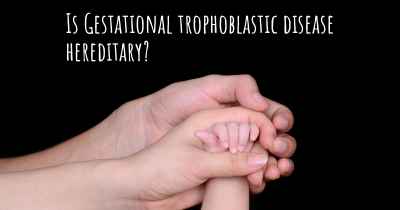What is the history of Gestational trophoblastic disease?
When was Gestational trophoblastic disease discovered? What is the story of this discovery? Was it coincidence or not?

Gestational trophoblastic disease (GTD) is a rare group of pregnancy-related disorders that originate from abnormal growth of cells in the placenta. These disorders can have significant implications for both the mother and the developing fetus. The history of GTD dates back to the early 20th century when it was first recognized and classified.
Early Observations:
The first documented case of GTD was reported in 1902 by Dr. J. Hammond, who described a patient with a rapidly growing uterine tumor following a molar pregnancy. However, it was not until the 1920s that Dr. John P. Sampson provided a comprehensive description of the disease and coined the term "chorioepithelioma" to refer to the malignant form of GTD.
Advancements in Diagnosis:
In the 1950s, Dr. Irving I. Gitlin introduced the use of the radioimmunoassay technique to measure the levels of human chorionic gonadotropin (hCG) in the blood. This breakthrough allowed for the early detection and monitoring of GTD, as hCG levels are typically elevated in affected individuals. The development of ultrasound technology in the 1960s further improved the diagnosis and management of GTD by enabling visualization of the abnormal placental tissue.
Classification and Treatment:
In 1973, the World Health Organization (WHO) established a classification system for GTD based on histopathological features. This system categorized GTD into two main types: hydatidiform mole (complete and partial) and gestational trophoblastic neoplasia (malignant forms). The classification system provided a standardized approach to diagnosis and treatment, facilitating research and improving patient outcomes.
Chemotherapy and Prognosis:
During the 1950s and 1960s, chemotherapy emerged as an effective treatment for GTD. Methotrexate, a folic acid antagonist, was found to be particularly successful in treating both low-risk and high-risk GTD cases. Subsequent studies demonstrated the efficacy of combination chemotherapy regimens, such as EMA-CO (etoposide, methotrexate, actinomycin D, cyclophosphamide, and vincristine), in achieving high cure rates for patients with malignant GTD.
Advances in Molecular Understanding:
In recent decades, significant progress has been made in understanding the molecular basis of GTD. Researchers have identified specific genetic alterations, such as mutations in the paternally derived genes, that contribute to the development of GTD. This knowledge has not only enhanced diagnostic accuracy but also opened avenues for targeted therapies and personalized medicine approaches.
Improvements in Patient Care:
Over the years, there have been notable advancements in the management of GTD, leading to improved patient care and outcomes. Multidisciplinary teams comprising gynecologists, oncologists, pathologists, and radiologists collaborate to provide comprehensive care to individuals with GTD. Regular follow-up, including hCG monitoring and imaging studies, allows for early detection of disease recurrence and prompt intervention.
Global Impact:
GTD affects women worldwide, although the incidence varies across different populations. In some regions, such as Southeast Asia, GTD is more prevalent. International collaborations and research efforts have contributed to a better understanding of the disease and the development of standardized treatment protocols.
Conclusion:
The history of gestational trophoblastic disease spans over a century, marked by significant milestones in diagnosis, classification, treatment, and molecular understanding. Advances in technology, such as radioimmunoassay and ultrasound, have revolutionized the diagnosis and monitoring of GTD. Chemotherapy regimens and targeted therapies have greatly improved patient outcomes. Ongoing research and international collaborations continue to enhance our knowledge of GTD, paving the way for further advancements in patient care.
1895 Marchland
Posted Sep 26, 2017 by Cindy 2120
Posted Nov 6, 2017 by MCHill 3050








